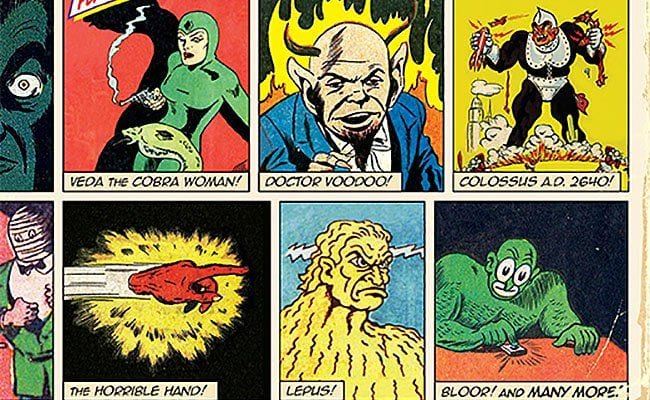
When it comes to comic books, a hero is only as good as his or her villains. While you might be familiar with foes like the Joker, the Green Goblin, or maybe Ultron, chances are you’ve never heard of Sadly-Sadly, Uzzi the Clown, or The Scarlet Beetle. And for good reason. However, author Jon Morris is out to change that with The Legion of Regrettable Supervillains.
Morris, a cartoonist and graphic designer, began surveying the stranger side of comics on his blog “Gone & Forgotten” many years ago before publishing The League Regrettable Superheroes with Quirk Books. In this follow-up volume, The Legion of Regrettable Supervillains, Morris explores more than a hundred of the strangest comic book villains to find their way onto paneled pages since 1938.
The new, equally enjoyable volume follows the same format as Regrettable Superheroes as it compiles brief overview of each of the included villains. There’s a brief synopsis of each antagonist alongside Morris’ reliably droll commentary. One of the best aspects of the collection is that vintage full-color artwork is also showcased for each rogue. Some villains are shown on a comic book cover while others are revealed via full pages of long-forgotten issues so you can see from characters like Bloor, the dictator of Uranus, in action — for better or for worse.
Morris surely had more source material to choose from for this volume, as there are countless comic book villains in the history of the medium. When it comes to comics, there are easily way more bad guys than good guys. Even a superhero that had his book canceled after a single year of publication has probably faced at least half a dozen different foes along the way. This may make Morris’ selections questionable for some fanboys, who may argue, for example, that nothing about Iron Man villain MODOK is “regrettable”, or who may ponder why a villain as equally dull and obscure as Cat Girl (a Catwoman knock-off circa 1962) made the cut.

The entries are categorized into three chronological sections: The Golden Age (1938-1949), The Silver Age (1950-1969), and the Modern Age (1970-today). This organization not only provides some consistency for readers, but it also goes to show you that each passing decade is not without some ridiculous ideas for villains. The selections run the gamut from rip-offs of The Joker like Bull’s-Eye or the Clown to disturbing World War II-inspired villains like the Dictator, a literal combination of Hitler and Satan. Included are lesser-known Marvel villains like Mr. Fish and Stilt-Man and uncanny oddities like the bodybuilding mutant chicken Powerhouse and Swarm, an adversary made entirely of not just any bees — Nazi bees.
Some of the included villains seemed to be doomed to never stand the test of time simply thanks to their name alone, like The Generic Man, The Dude, Ugly Man, and He-She. Others are perhaps deemed regrettable by their powers like Batroc the Leaper who, as you may guess, is especially good at leaping or Police Comics’ BrickBat, a crook who dresses like Batman but insists on exclusively throwing a bricks at his victims.
As with his Regrettable Superheroes book, Morris does sometimes go for the obvious, irreverent jokes, but you can’t blame him. They work. However, what’s more impressive is how the author also takes time to explain the merits of even the most laughable characters, even if a character is (accurately) described as a leering, mustachioed, giant sentient egg larger than a ten-story building (“Egg Fu”).
Take, for example, the aforementioned Egg Fu. Morris writes, “To Egg Fu’s credit, he accomplishes something no other supervillain had yet been able to do: he destroys Wonder Woman and her paramour Steve Trevor, reducing them to ash. (They get better by the end of the story, don’t worry.)”
All in all, there’s something to be said for the surprising level of regard Morris holds for the material, no matter how peculiar or embarrassing. As Morris’ writes in the introduction, “Every one of them had the potential to join the ranks of comicdom’s icons of iniquity. It was only poor sales, inopportune timing, and occasional overshadowing from bigger baddies that consigned so many of these scoundrels to the scrapheap…”
His commentary is rarely laugh-out-loud funny, but if the premise of the book seems remotely intriguing to you, there’ll be plenty of smiles along the way and more to learn that you might presume as you read about these oddball adversaries.
As with the previous volume, if you pick up The Legion of Regrettable Supervillains expecting continuous humor, you’ll be surprised that there are more insights about the nature of the comic industry and trends in popular culture than straightforward words of comedy in this enjoyable collection. For a book about the most ludicrous of comic book bad guys, that’s not bad at all.

